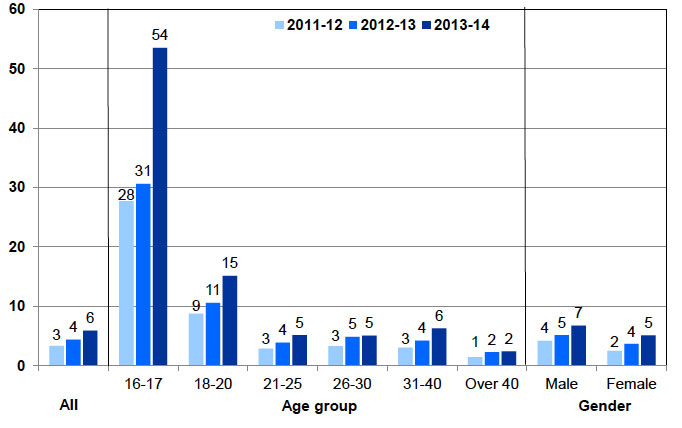Criminal justice social work statistics in Scotland: 2013-14
An annual publication of statistics on community payback and other social work orders, including breaches and terminations of orders, as well as criminal justice social work (CJSW) reports and other areas of CJSW.
This document is part of a collection
3 Diversion from prosecution
3.1 In the case of more minor offences, the procurator fiscal may decide to refer the case to criminal justice social work rather than prosecuting the individual through the courts or offering fiscal direct measures. In such cases, prosecution is waived, subject to successful completion of the scheme. Diversion from prosecution schemes have been in existence in Scotland since the early 1980s and aim to provide support and advice in relation to the underlying causes of offending, such as problematic substance use. In the late 1990s, the Scottish Office provided funding for a number of pilot schemes, which were rolled out across Scotland in 2000.
3.2 Historically, diversion involves relatively low volumes compared to other fiscal disposals such as fines and warnings, or court proceedings. However, while the number of diversion cases commenced fluctuated around the 1,000 mark between 2007-08 and 2010-11, they have more than doubled over the past three years to 2,250 during 2013-14. The number of cases rose by over a third (35 per cent) in 2013-14 compared with 2012-13 (Table 1). During 2013-14, there were 2,900 referrals, 2,800 assessments and 1,500 cases completed, representing increases of 83, 97 and 83 per cent respectively since 2010-11 (Table 2).
3.3 The rise in the number of diversion cases is not consistent across all local authorities, although a large number of authorities showed an increase. Further information is provided in the additional datasets which accompany this publication.
3.4 The age group with the sharpest rise between 2012-13 and 2013-14 was the under 18s (75 per cent). As a result, almost 30 per cent of cases in 2013-14 were for under 18s with those aged 18 to 20 accounting for a further 14 per cent (Table 3). Under 21s are over-represented when the population base is taken into account which likely reflects a general focus on diversion for this age group (Chart 2).
Chart 2 Diversion from prosecution cases commenced per 10,000 population by age and gender: 2011-12 to 2013-14

3.5 Half of diversion cases commenced in 2013-14 involved offenders who were unemployed (Table 3). On the whole, those diverted to social work are less likely to be unemployed than those getting community payback / drug treatment and testing orders.
Contact
Email: Alan Fleming
There is a problem
Thanks for your feedback